Brand collaborations are a smart way for your small-to-medium-sized business to challenge larger competitors. They help you tap into new markets, share marketing costs and build credibility by association.
In this guide, you’ll learn about the most effective types of company collaboration, see seven successful brand partnership examples and learn practical steps to launch your joint ventures.
What is a brand collaboration?
A brand collaboration occurs when two or more companies collaborate to achieve mutual or separate business goals. It can involve joint marketing campaigns, product launches, sponsorships or any other initiative that benefits all parties.
The best brand partnerships see companies combine their strengths and resources to create something more valuable than they could achieve alone.
For example, English fashion brand Wales Bonner began collaborating with sportswear company Adidas on limited-edition products in 2014.
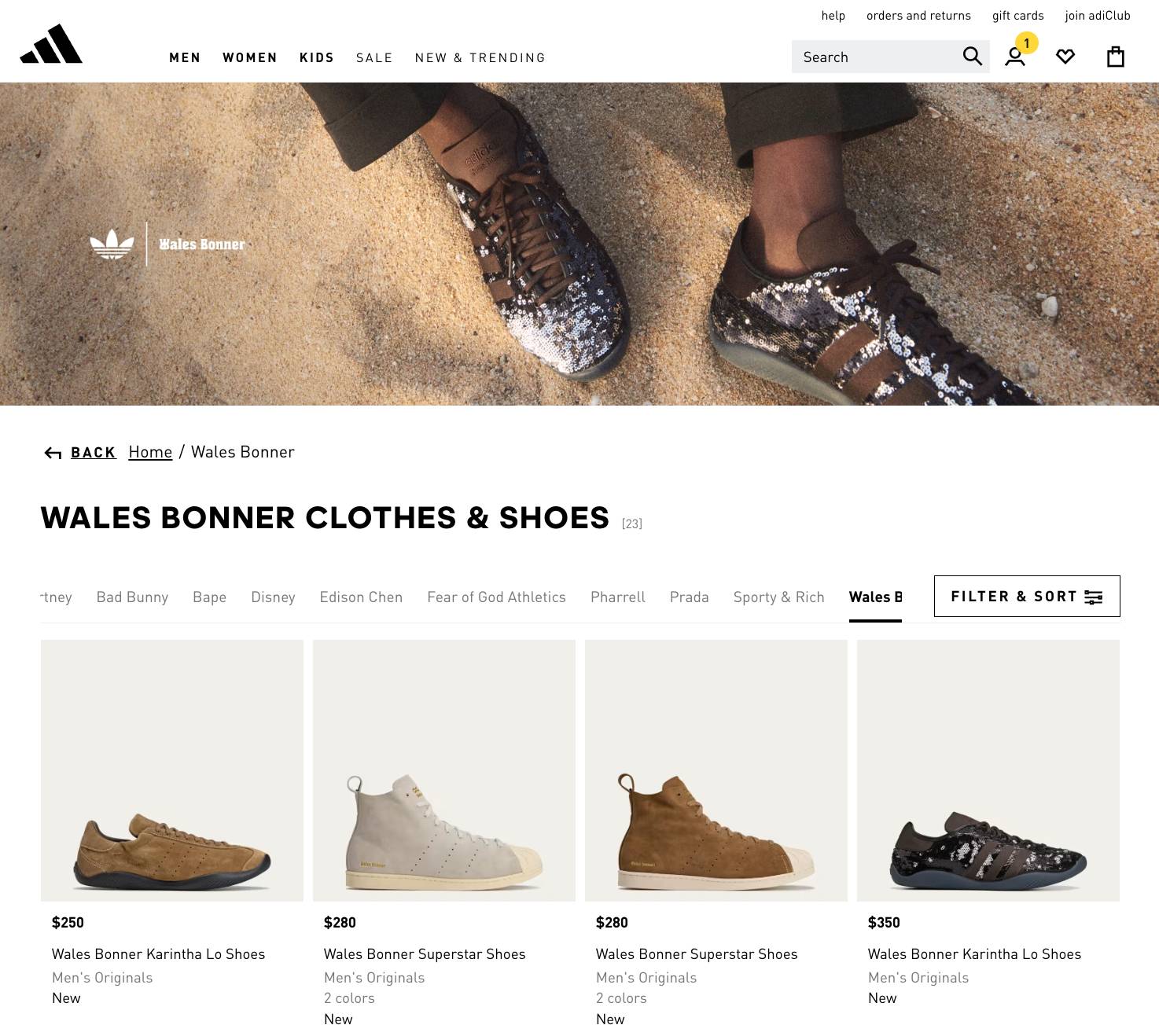
Wales Bonner, a relatively niche clothing brand, grows awareness through Adidas’ larger platform. Adidas generates hype by working with an emerging designer. It’s a win-win situation.
An example of a business-to-business (B2B) brand partnership is how software firms work together to integrate their products and improve customer experiences, like Pipedrive and Slack synchronizing to speed up users’ workflows.
Here are the main types of brand collaboration that startups and small businesses benefit from:
Brand collaboration type | How it works |
Influencer partnerships | Brands work with content creators to reach new audiences |
Cross-promotional campaigns | Companies market each other’s products through cross-promotion |
Affiliate marketing programs | Partners earn commission for driving sales or leads |
Content collaboration | Brands create joint content like co-hosted webinars or guides |
Product co-creation | Companies develop new products or features together |
Technology integrations | Software platforms connect to improve user experiences |
The terms “brand collaboration” and “co-branding” overlap a lot. However, brand collaboration is generally the broad umbrella for all forms of joint ventures, while co-branding means openly creating new products together (like the Wales Bonner x Adidas example).
Note: “Brand collaboration”, “brand partnership” and “brand collab” are interchangeable terms.
The 3 main benefits of brand partnerships for SMBs
Companies willing to share resources and audiences can make marketing more cost-effective and expand customer bases fast.
Here are the most significant benefits of brand collaborations in more detail.
1. Reach new audiences cost-effectively
Brand collabs open the door to your partners’ audience, letting you access customer demographics or volumes you can’t reach through your website or social media platforms.
For example, as part of its Open for Business Fund, Wells Fargo promotes small business partners to over 140,000 Instagram followers.
This post features Cold Mountain Consulting, which has fewer than 500 followers on its account:
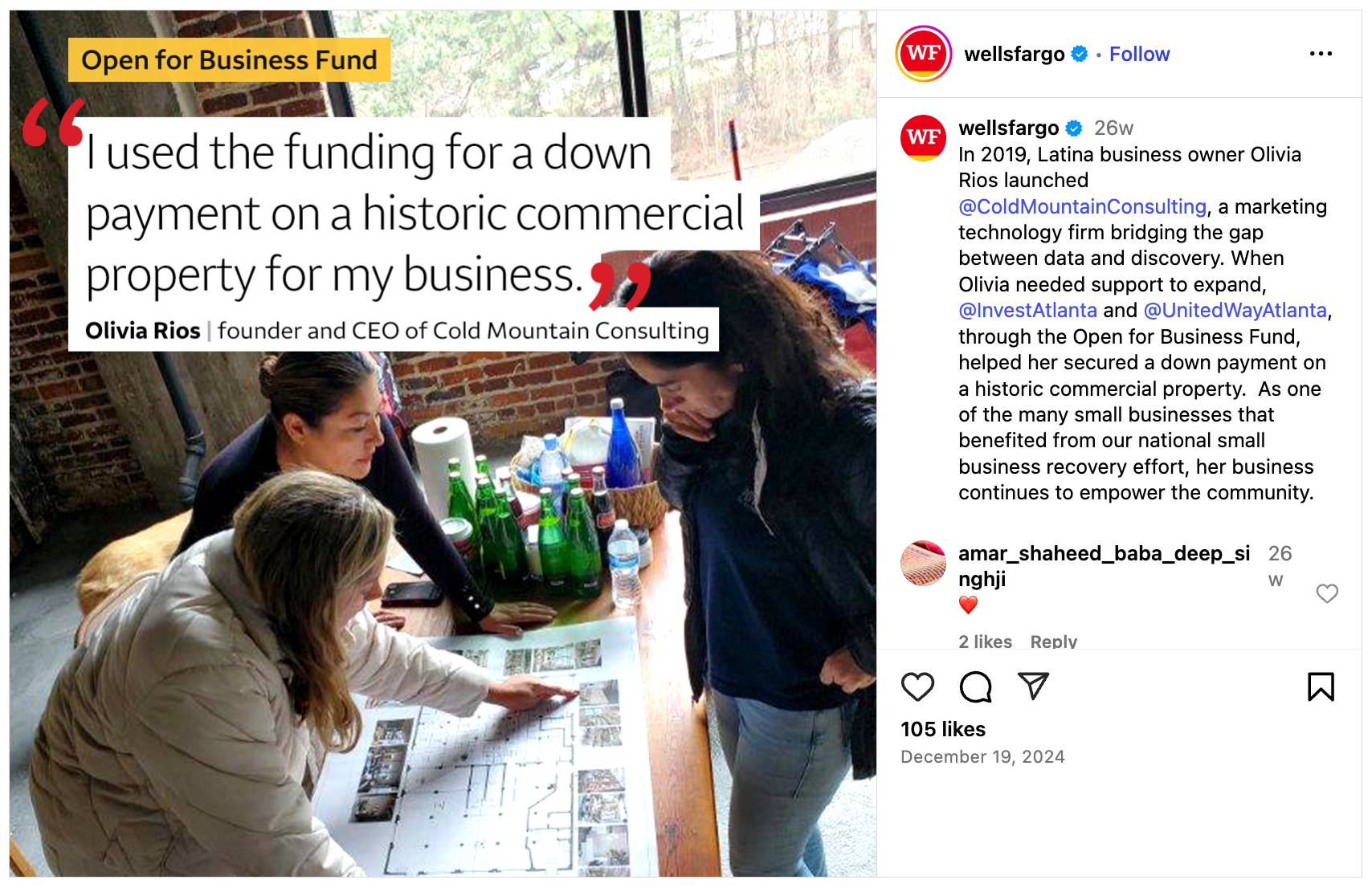
Sharing campaign costs makes ambitious marketing strategy ideas more feasible without stretching individual budgets. It could pull a television ad within budget, for example.
2. Build credibility through association
Trust transfer is the idea that buyers are more likely to trust your brand if another endorses it that they already know and respect. It helps enter new industries.
For instance, when action camera brand GoPro partnered with the US motorsports series, it gained trust from those organizations’ fan bases despite being in a different sector.
Trust transfer also helps startups. With the correct associations, young businesses can overcome early skepticism while building brand awareness.
Download Your Sales and Marketing Strategy Guide
3. Drive sales through shared expertise
Working with complementary brands also benefits you from new skills, whether they’re abilities you don’t need long-term or haven’t had time to learn.
For example:
Coffee shops partner with local bakeries to serve high-quality food and drink together
Web design firms team up with hosting services to help clients get online faster
Accountants and legal professionals join to give SMB clients more complete support
Other borrowed skills small businesses find valuable include content creation, digital marketing and podcast production.
By pooling this knowledge, you can create better offers and more innovative campaigns. You’ll create smoother customer experiences, leading to more sales and loyalty.
7 successful brand collaboration examples (and why they work)
One of the best ways to generate ideas for new brand collaborations is to see how other companies succeeded.
Here are seven examples of brand partnerships that helped B2B and B2C businesses, large and small, to grow audiences and revenue.
1. Pipedrive x Zapier: versatile automation without the hassle
Pipedrive and Zapier have combined forces to streamline users’ sales and general business workflows.
Teams with both tools can sync Pipedrive sales data across more than 5,000 popular apps, such as Gmail, Slack and Google Sheets. This unlocks the ability to trigger follow-ups or update deals from outside the customer relationship management (CRM) system interface.
This collaboration turns Pipedrive into a more comprehensive business hub.
Instead of constantly bouncing between sales tools and others, users can build Zaps to eliminate manual steps, like recording new events as activities or turning social media ad leads into Pipedrive contacts automatically.
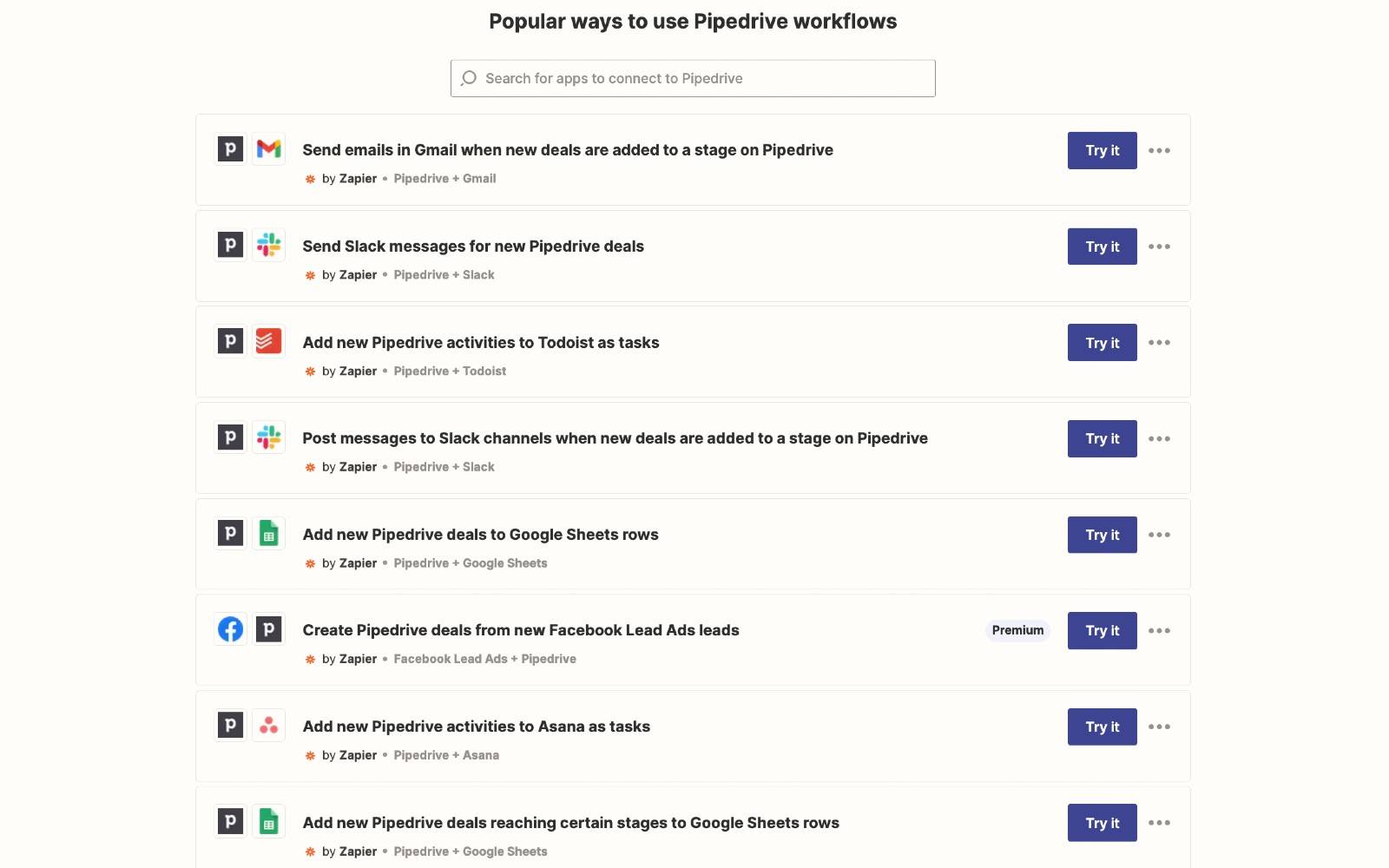
This partnership lets salespeople focus on nurturing deals instead of switching tools or finding information. According to Gartner, 47% of digital workers struggle to find the information they need to perform their jobs. By sharing data, Pipedrive and Zapier solve that issue.
Why it works: The collaboration solves a common sales pain point where app-switching and manual data entry hinder productivity, negatively impacting deals.
Key SMB takeaway: List functions that your primary audience needs but that you can’t reasonably offer. Partner with providers of tools that fill those gaps simply and reliably.
2. Xero x Shopify: SaaS integration for e-commerce
Xero and Shopify created a software integration to connect their accounting and e-commerce functions. It allows business owners to automatically sync orders, track inventory and create financial reports from one interface.

This partnership is all about removing administrative friction for busy founders and managers. HBR researchers found the average digital worker loses four hours a week toggling tools. Xero and Shopify help them regain some of that time.
Why it works: Individually, these brands solve different problems for the same target audience of business owners. Together, their integration addresses a real shared challenge – manual data entry between systems.
Key SMB takeaway: Look for partnerships that solve genuine customer pain points rather than just expanding your reach. Sharing an audience is a great starting point.
3. HostGator: affiliate and reseller programs for web hosting
HostGator’s affiliate program lets content creators – like business owners and micro-influencers – earn commission for promoting its web hosting services to their networks.
The company’s reseller scheme goes deeper, letting IT consultants and agencies sell its services with a markup as their branded solutions (i.e., white-labelling).
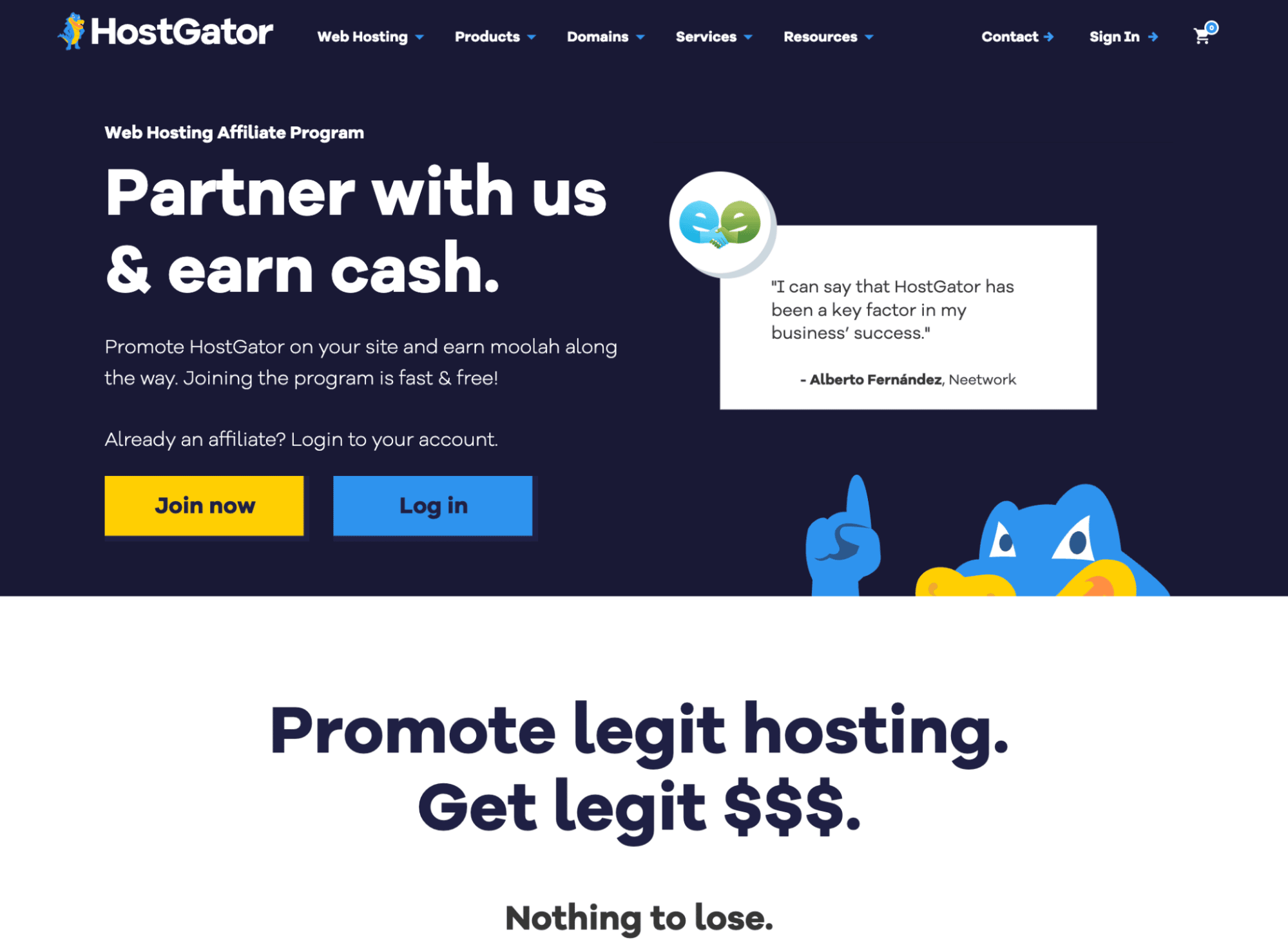
Other industries that suit affiliate and reseller programs are insurance, where independent brokers sell major providers’ policies, and travel, where agencies repackage flights and accommodation.
Why it works: This model helps HostGator find new customers through trusted local partners who already have niche audiences or strong client relationships. Its partners generate revenue without needing to spend big on hosting infrastructure.
Key SMB takeaway: Look for potential partners who serve your target audience on a smaller scale, such as freelancers, consultants, influencers or service providers.
Give them simple ways to integrate your services into their work and promote them effectively. That might mean an affiliate link with commission, or a white-labeled version of your service that they can bundle into what they already do.
Better understand your customers with our Buyer Persona Templates
4. Nike x Tiffany & Co: sportswear meets luxury
Nike and Tiffany & Co. launched a limited-edition product collaboration merging streetwear with high-end jewelry. They created exclusive sneakers and accessories targeting their target audiences’ (relatively small) cross-section.
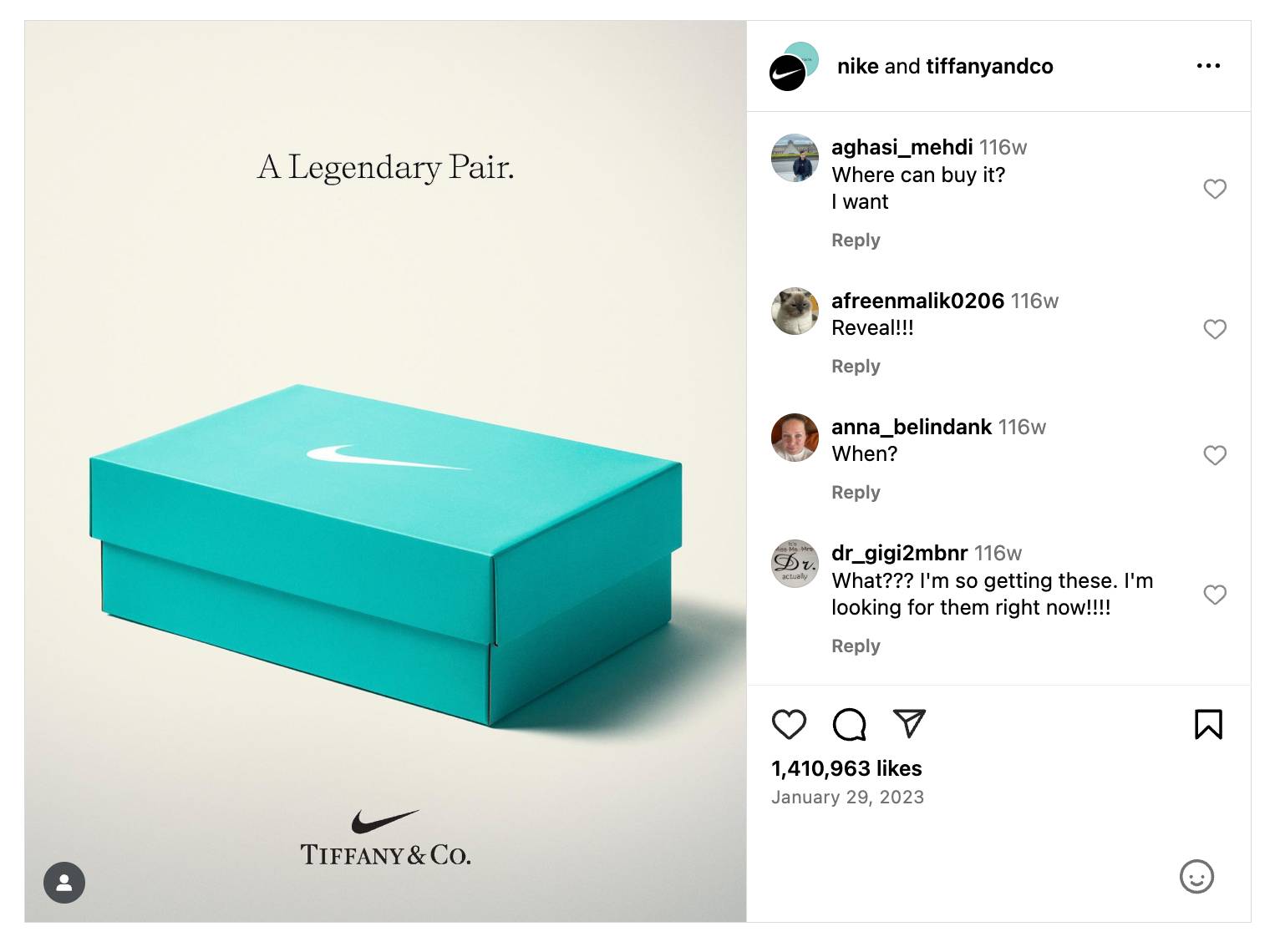
This successful partnership generated massive hype across social media, with users rushing to discuss the unexpected collab and share imagery (the post above generated over 1.4 million likes). The products sold out quickly, raising both brands’ profiles.
Why it works: Both brand partners share premium positioning and lifestyle appeal but serve different demographics. The collaboration created exclusivity and novelty, and people didn’t need to buy to join the conversation.
Key SMB takeaway: Don’t restrict yourself to obvious industry matches. Shared brand values and target audience overlap matter more than direct product similarities.
5. McDonald’s x BTS: celebrity brand collaboration
McDonald’s partnered with the K-pop music group BTS to create a global campaign around a special meal combination: the “BTS Meal”.
Promoted heavily across TikTok and other social channels, the collaboration drove viral engagement, introducing younger consumers (i.e., BTS fans) to a legacy brand’s products.

Such a collaboration is a large-scale example of influencer marketing, with two established brands combining huge audiences to grow each other’s relevance further and reach.
Why it works: BTS’s massive, devoted fan base gave McDonald’s instant reach and engagement. The partnership felt authentic because it tied into both parties’ brand values around fun, energy and community.
Key SMB takeaway: Ensure influencer marketing collabs align naturally with both partners’ existing brand personalities. Look for overlaps in how you present in marketing content (e.g., tone of voice, visual style).
6. GoPro x Red Bull: long-term content marketing partnership
GoPro and Red Bull created a multi-year partnership yielding co-branded marketing campaigns, sponsorship deals, co-hosted events and more.
Both brands are deeply connected to adventure and action sports (thanks to previous marketing efforts and collaborations). They’ve consistently used that shared identity to engage audiences through high-energy, visually compelling content.
Here’s an example:

The brands’ products and branding often appear together (e.g., the action shot above), blurring the line between where one brand ends and the other begins. That level of overlap takes perfect alignment and close collaboration, but it pays off in cultural relevance and customer loyalty.
Why it works: Each brand plays a vital role in the other’s ongoing brand story. They consistently show up together, reinforcing shared values to make each feel more authentic to their action-sport-minded audience.
Key SMB takeaway: Explore ways of working with like-minded businesses beyond just one-off campaigns. With time and consistency, ongoing content collaboration can strengthen both brands in the audiences’ minds.
7. Pip Organic x Double Dutch x Little Moons: female business collective
Pip Organic, Double Dutch and Little Moons are three independent, women-led food-and-drink brands that ran a collaborative giveaway campaign during Women’s Month (March).
With backing from Buy Women Built, the growing brands offered a “mocktail bundle” of products in exchange for new followers, likes and shares on social media.
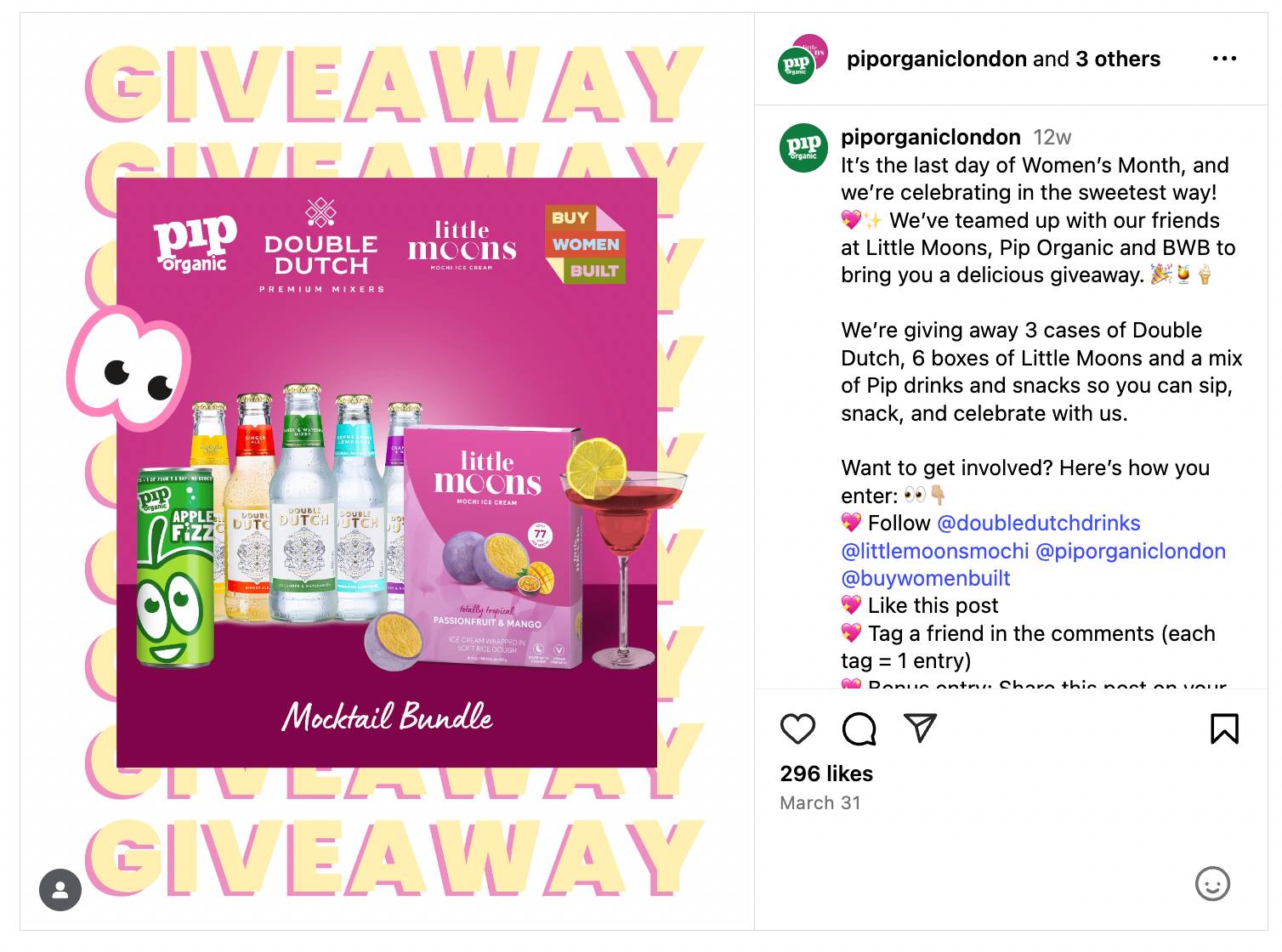
Combining audiences was a low-cost, high-reach tactic to increase engagement fast, highlighting shared values around female entrepreneurship (i.e., strengthening their individual brand stories).
Why it works: These brands share an audience and a message: female-led, high-quality food retailers with a values-driven USP. Teaming up expanded their reach while building credibility through association.
Key SMB takeaway: Use your shared values to forge relationships with like-minded business owners. People love discussing their passions, and genuine connections can lead to helpful partnerships.
How to find and execute successful brand collaborations
Forming effective partnerships takes careful organization. Make the process manageable by breaking it into three simple stages: identifying collaborators, structuring the partnership and managing your relationship.
Here’s what to do at each step.
Step 1: Identify and contact potential collaboration partners
Start by mapping complementary brands that share your target audience but sell different products.
Look for companies where partnerships could create value for both sets of customers, rather than confusion in the marketplace (i.e., avoid working with direct competitors).
Prioritize these criteria:
Audience alignment and shared values. Your ideal collaborators serve the same customers in different ways. For example, an accounting software firm might partner with a document management app because they help management professionals but don’t compete for the same new users.
Complementary products. Do your products naturally work well together? Pipedrive’s CRM system integrates with Gmail because that’s how many salespeople communicate. Combining the two tools makes users’ lives easier.
Brand reputation and credibility. Choose brands whose reputations you’re happy to associate with, as distrust transfers like trust. Their negative press could easily hurt your business. Lots of poor reviews and confrontational social posts are clear red flags.
Reach out to the best candidate with a clear value proposition. Tell them why you think working together makes sense and what both parties will gain from a relationship.
If you both agree in principle, move to the next step. If not, contact the next name on your shortlist and go again.
Step 2: Structure your partnership
Set clear expectations to avoid misunderstandings. Define what you want to achieve so that you can both measure success once the collaboration’s underway.
Here’s what strong alignment looks like:
Clear goals and key performance indicators (KPIs). What does success look like? You may both want brand awareness or more leads, while your collaborator needs direct sales. Use these objectives to pick specific metrics to track, like website traffic or deals closed.
Communication expectations. Choose how you’ll communicate and share resources. Which channels work best, and how often will you use them? Will you pool audience research, or is that too sensitive? Schedule necessary meetings to give everyone notice.
Meeting the team. If the work involves others, get them together for an informal kick-off meeting. A team that knows each other will feel more comfortable raising issues and pitching ideas. A dedicated Slack or MS Teams channel will help.
Just like customer relationships, strong partnerships depend on clarity and trust. Start early so everyone stays on the same page as things progress.
Step 3: Manage and measure the relationship (with tech)
When the partnership goes live, treat it like any other valuable relationship: track, manage and keep working on it.
More specifically, use your CRM and project management systems to:
Log activity and monitor progress. Record key touchpoints, shared campaigns and any agreed milestones. It’ll help you stay aligned and avoid duplicate tasks.
Track results. Monitor performance using your agreed-upon KPIs (business-specific and shared). Most CRMs have dashboards for tracking conversions, deal value, etc.
Find opportunities (and issues). Check in regularly to share improvement ideas and discuss challenges. Both parties will have unique perspectives from which the other can learn.
Keep the relationship warm. The best brand collaborations don’t stop after a single campaign. Use your CRM to remind you of upcoming opportunities and stay in regular contact.
What’s a brand partnership without a clear view of its effectiveness? Pipedrive’s custom dashboards turn raw data from your collaborations into easily digestible, visual insights, like this
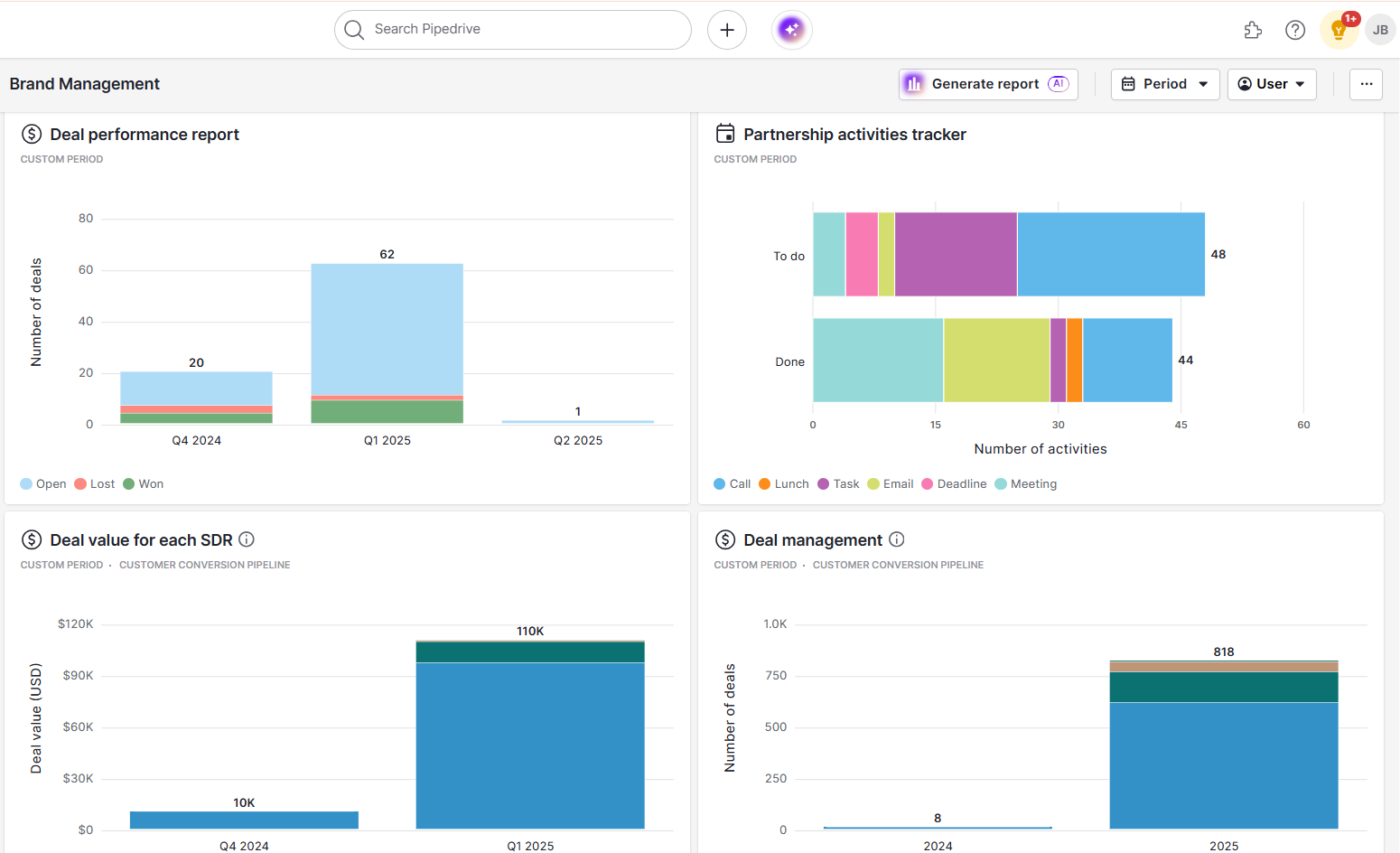
Finally, recognize when a partnership doesn’t go smoothly. Even with the best intentions, a great plan can fall flat. The most helpful response is to reflect on what went well and learn from what didn’t.
Final thoughts
Small businesses often focus so heavily on outperforming competitors that they forget there’s power in teaming up.
Brand partnerships are so much more than just opportunities to share audiences. They enable you to combine strengths. They help you solve customer problems effectively. Ultimately, they help you grow faster than you could solo.
Start by looking for overlapping customers and a straightforward way to add value. As your partnerships develop, CRM systems like Pipedrive can help you manage these relationships systematically, tracking partnership performance and nurturing long-term collaborations.
With the right approach, one small collaboration can open the door to significant opportunities.







